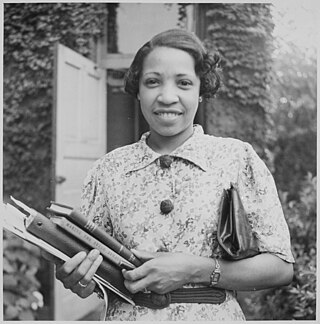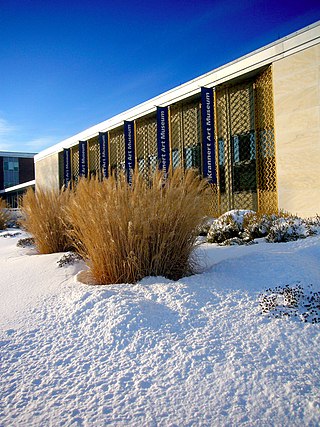
Victor Ekpuk (born 1964) is a Nigerian-born artist based in Washington, DC. Ekpuk came to prominence through his paintings and drawings, which reflect indigenous African philosophies of the Nsibidi and Uli art forms. [1]

Victor Ekpuk (born 1964) is a Nigerian-born artist based in Washington, DC. Ekpuk came to prominence through his paintings and drawings, which reflect indigenous African philosophies of the Nsibidi and Uli art forms. [1]

Ekpuk's work frequently explores the human condition of identity in society. [2] It draws upon a wider spectrum of meaning that is rooted in African and global contemporary art discourses. [3] [4] In 1989 Victor received his Bachelor of Fine Art degree (BFA), Obafemi Awolowo University, Ife, Nigeria, where he first explored the aesthetic philosophies of Nsibidi. [5] Its economy of lines and encoded meanings led him to further explore drawing as writing, and to the invention of Ekpuk's own Glyphs. In a 2017 issue of Diaspora Quarterly, Visual Collaborative cited Ekpuk's work on the heritage of Africa art. [6] In 1991, Ekpuk joined the Daily Times Nigeria (DTN), a government-controlled media outlet. [7] Ekpuk joined DTN as an illustrator between June 17, 1991, and October 29, 1997, at the Daily Times of Nigeria, and was responsible for developing visual material for columns in the Daily Times and its related publications. [7] Despite the tense political climate, arising from authoritarian military rule in Nigeria, Ekpuk delivered several thought-provoking satirical designs that traversed the political terrain in the country. His unique style consisted of political cartooning and his own unique Nsibidi inspired illustration. [7] A notable example of illustrations from Ekpuk's time with DTN are from The New Agenda: Behind Abacha’s Game-Plan, an article covering the bloodless coup d'état that removed Ibrahim Babangida from his seat as military head of state. [7]
His artworks are in private and public collections, such as Smithsonian Institution National Museum of African Art, [8] Newark Museum, The World Bank, University of Maryland University College, Hood Museum, United States Art in Embassies Art Collection and the Fidelity Investment Art Collection.
Ekpuk's work have been featured at venues including: Krannert Art Museum, [9] Champaign, Illinois; The Fowler Museum, Los Angeles; Museum of Art and Design (MAD), New York City; Newark Museum, New Jersey; The World Bank, Washington DC; Smithsonian Institution, National Museum of African Art, Washington DC; New Museum of Contemporary Art, New York City; Johannesburg Biennial, South Africa.

Lois Mailou Jones (1905–1998) was an artist and educator. Her work can be found in the collections of the Smithsonian American Art Museum, The Metropolitan Museum of Art, the National Museum of Women in the Arts, the Brooklyn Museum, the Museum of Fine Arts, Boston, Muscarelle Museum of Art, and The Phillips Collection. She is often associated with the Harlem Renaissance.

Keith Anthony Morrison, Commander of Distinction (C.D.), born May 20, 1942), is a Jamaican-born painter, printmaker, educator, critic, curator and administrator.
Obiora Udechukwu is a Nigerian painter and poet.
Christopher Uchefuna Okeke, also known as Uche Okeke, was an illustrator, painter, sculptor, and teacher. He was an art and aesthetic theorist, seminal to Nigerian modernism.

The Krannert Art Museum (KAM) is a fine art museum located at the University of Illinois Urbana-Champaign in Champaign, Illinois, United States. It has 48,000 square feet (4,500 m2) of space devoted to all periods of art, dating from ancient Egypt to contemporary photography. The museum's collection of more than 11,000 objects can be accessed online and includes specializations in 20th-century art, Asian art, and pre-Columbian art, particularly works from the Andes.

Nnenna Okore is an Australian-born Nigerian artist who lives and works in Chicago at North Park University, Chicago. Her largely abstract sculptural forms are inspired by richly textured forms and colors within the natural environment. Okore's work frequently uses flotsam or discarded objects to create intricate sculptures and installations through repetitive and labor-intensive processes. She learnt some of her intricate methods, including weaving, sewing, rolling, twisting and dyeing, by watching local Nigerians perform daily domestic tasks. In her more recent works, Okore uses plant-based materials to create large bioplastic art forms and installations. Her work has been shown in galleries and museums within and outside of the United States. She has won several international awards, including a Fulbright Scholar Award in 2012. and the Australian Creative Victoria Award in 2021.
Samson Kambalu is a Malawi-born artist, academic and author who trained as a fine artist and ethnomusicologist at the University of Malawi's Chancellor College. He is a Fellow of Magdalen College, Oxford.
George Nene (1959–2005) was one of Zimbabwe's best known artists. In 1988 his contributions to the nation were memorialized on a Zimbabwean stamp.
Marcia Kure is a Nigerian visual artist known primarily for her mixed media paintings and drawings that engage with postcolonial existentialist conditions and identities.
Mustafa Maluka is an artist known for his portraits.
Contemporary African art is commonly understood to be art made by artists in Africa and the African diaspora in the post-independence era. However, there are about as many understandings of contemporary African art as there are curators, scholars and artists working in that field. All three terms of this "wide-reaching non-category [sic]" are problematic in themselves: What exactly is "contemporary", what makes art "African", and when are we talking about art and not any other kind of creative expression?

Bruce Obomeyoma Onobrakpeya is a Nigerian printmaker, painter and sculptor. He has exhibited at the Tate Modern in London, the National Museum of African Art of the Smithsonian Institution in Washington, D.C., and the Malmö Konsthall in Malmö, Sweden. The National Gallery of Modern Art, Lagos has an exhibit of colourful abstract canvases by Onobrakpeya and his works can be found at the Virtual Museum of Modern Nigerian Art, although no exhibitions were showing as of October 2017.
Michael Tsegaye is an Ethiopian artist and photographer. Much of his work presents a glimpse of life in contemporary Ethiopia, although an extended catalogue of his images come from his travels abroad.
Allan deSouza is a Kenyan-born American photographer, art writer, professor, and multi-media artist. He is of Indian descent and his work deals with issues of migration, relocation, and international travel. He works in the San Francisco Bay Area, where he serves as the Chair of the Department of Art Practice at the University of California, Berkeley.
Martha Jackson Jarvis is an American artist known for her mixed-media installations that explore aspects of African, African American, and Native American spirituality, ecological concerns, and the role of women in preserving indigenous cultures. Her installations are composed using a variety of natural materials including terracotta, sand, copper, recycled stone, glass, wood and coal. Her sculptures and installations are often site-specific, designed to interact with their surroundings and create a sense of place. Her works often focus on the history and culture of African Americans in the southern United States. In her exhibition at the Corcoran, Jarvis featured over 100 big collard green leaves, numerous carp and a live Potomac catfish.
Joyce J. Scott is an African-American artist, sculptor, quilter, performance artist, installation artist, print-maker, lecturer and educator. Named a MacArthur Fellow in 2016, and a Smithsonian Visionary Artist in 2019, Scott is best known for her figurative sculptures and jewelry using free form, off-loom beadweaving techniques, similar to a peyote stitch. Each piece is often constructed using thousands of glass seed beads or pony beads, and sometimes other found objects or materials such as glass, quilting and leather. In 2018, she was hailed for working in new medium — a mixture of soil, clay, straw, and cement — for a sculpture meant to disintegrate and return to the earth. Scott is influenced by a variety of diverse cultures, including Native American and African traditions, Mexican, Czech, and Russian beadwork, illustration and comic books, and pop culture.

Victor Ehikhamenor is a Nigerian visual artist, writer, and photographer known for his expansive works that engage with multinational cultural heritage and postcolonial socioeconomics of contemporary black lives. In 2017, he was selected to represent Nigeria at the Venice Biennale, the first time Nigeria would be represented in the event. His work has been described as representing "a symbol of resistance" to colonialism.

Senzeni Marasela is a South African visual artist born in Thokoza who works across different media, combining performance, photography, video, prints, textiles, and embroidery in mixed-medium installations. She obtained a BA in Fine Arts at the Wits School of Arts, University of the Witwatersrand, Johannesburg in 1998. Her work is exhibited in South Africa, Europe, and the United States, and is part of local and international collections, including Museum of Modern Art or the Newark Museum and is referenced in numerous academic papers, theses journal, and book publications.

Bernard Akoi–Jackson, is a Ghanaian academic, artist and writer. He is known for projects that are in continual metamorphosis. His art works are mostly performative, or pseudo-rituals. His writings are focused on the development of contemporary African, Ghanaian visual arts and culture in poetic and jovial manner. He is known as a proverbial jester using critical absurdity to move between installations, dance and poetry, video, and photography. He blends post-colonial African identities through transient and makeshift memorials.

Medu Art Ensemble was a collective of cultural activists based in Gaborone, Botswana during the height of the anti-apartheid resistance movement during the late twentieth century. The collective formed originally in 1977 as a group of black South African artists mutually invested in regional liberation struggles and resistance to South Africa’s apartheid policy of racial segregation (1948-1994). Medu’s members, or “cultural workers” as they preferred to be called, eventually organized and relocated to Gaborone, Botswana in 1978. They felt that the term "cultural workers" was far more fitting to their mission rather than referring to themselves as artists because the such a pursuit was regarded as something trivial and therefore inherently elitist and white. With the support of the African National Congress (ANC), in Gaborone Medu officially registered as a cultural organization with the Botswanan government. Medu means “roots” in the Northern Sotho language, and so describes the collective's underground operations. The collective’s cultural work was rhizomatic in nature, stretching across seven semi-autonomous units: Film, Graphics, Music, Photography, Poetry, Publishing and Research, and Theatre.